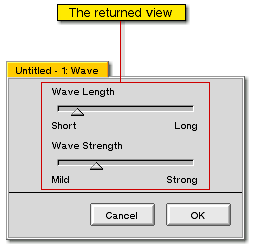

|

|
|
WindowGUIManipulator-classDerived from: public GUIManipulatorDeclared in: WindowGUIManipulator.h
OverviewThe classes that inherit from WindowGUIManipulator are manipulators that put up a GUI in a separate window. This has the advantage over the StatusBarGUIManipulator that the GUI can be as complex as needed and can contain numerous controls. However the disadvantage is that a separate window is needed for the GUI. |
||
Constructor and Destructor |
||
WindowGUIManipulator()WindowGUIManipulator()Does nothing. |
||
~WindowGUIManipulator()virtual ~WindowGUIManipulator()Does nothing. |
||
Member Functions |
||
|
|
||
MakeConfigurationView() virtual BView* MakeConfigurationView(const BMessenger&
target)
This function should create and return a view that contains the necessary
controls for the manipulator. The view can be made a child of
WindowGUIManipulatorView, but it is not absolutely necessary to do so.
The returned view will be positioned in a window that has OK- and Cancel-buttons,
as shown in the following picture. The target should be copied.

Whenever the value of one of the controls is changed, that change should also be reported to this manipulator. This is most conveniently done by calling the SetManipulatorSettings-function. If a continuos preview is needed when the control (e.g. a slider) is adjusted a message should be sent to target when the adjusting is started. The what-member of that message should be HS_MANIPULATOR_ADJUSTING_STARTED. When the adjusting is finished another message should be sent to target. That message should have HS_MANIPULATOR_ADJUSTING_FINISHED as its what-member. Note that HS_MANIPULATOR_ADJUSTING_STARTED - message must always be followed by HS_MANIPULATOR_ADJUSTING_FINISHED - message at some later point. |
||
|
|
||
|
|
||
